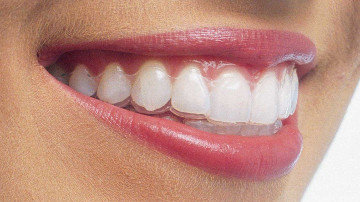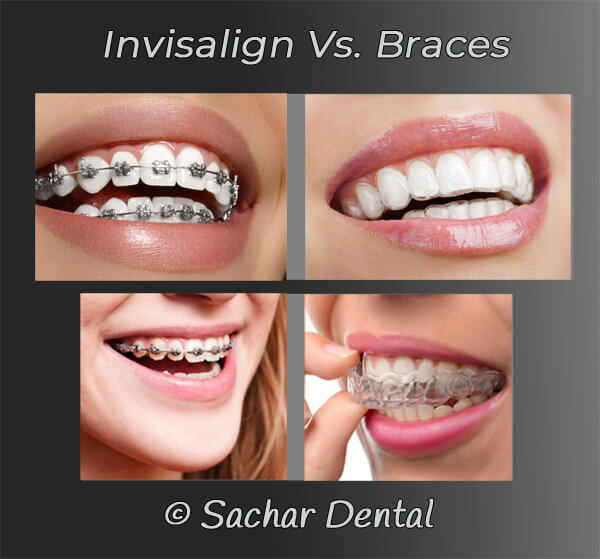The Ultimate Contrast: Invisalign vs. Traditional Dental braces for Grownups
The Ultimate Contrast: Invisalign vs. Traditional Dental braces for Grownups
Blog Article
Invisalign vs. Standard Dental braces: Which Option Is Right for You?
When thinking about orthodontic therapy, the option between Invisalign and conventional braces provides a number of crucial variables that warrant mindful evaluation. Invisalign provides a very discreet choice with removable aligners, while traditional braces give a much more visible yet reliable option for serious misalignment.
Introduction of Therapy Choices

On the other hand, typical dental braces consist of steel brackets and wires that are bound to the teeth. This method applies constant pressure gradually to achieve placement. While efficient for complicated orthodontic problems, typical dental braces require regular check outs for changes and can pose difficulties in keeping oral hygiene because of the problem of cleansing about cables and brackets.
Both alternatives have their advantages, and the option frequently rests on particular dental conditions, way of life choices, and individual conformity. Inevitably, speaking with an orthodontic expert is critical for identifying the most ideal therapy plan customized to specific requirements. Understanding the subtleties of each alternative can substantially affect the overall success of orthodontic therapy.
Aesthetic Factors To Consider
A significant aspect affecting the choice between Invisalign and typical dental braces is the aesthetic appeal each therapy supplies. Invisalign aligners are crafted from clear plastic, making them practically invisible when worn. This very discreet look is especially attracting teenagers and grownups that may feel uncomfortable regarding their orthodontic treatment. The ability to keep a natural smile throughout the positioning procedure can significantly improve the patient's confidence in social and professional setups.
On the other hand, conventional braces contain steel brackets and wires, which can be more noticeable. While improvements in orthodontic innovation have actually caused the development of smaller sized brackets and tinted elastics, conventional dental braces still maintain an even more noticeable profile. For some people, the presence of braces may discourage them from seeking required treatment.
Eventually, the selection between Invisalign and traditional braces may hinge on individual choices regarding visual appeals. Individuals that focus on discernment usually lean toward Invisalign, while those who are much less worried concerning exposure may select standard braces. Comprehending the aesthetic implications of each choice is essential for making an educated decision that lines up with one's way of life and preferences.
Convenience and Convenience

In regards to convenience, Invisalign aligners are removable, allowing individuals to appreciate their favorite foods without limitation and keep optimal dental health. Brushing and flossing are streamlined, as the aligners can be taken out throughout these routines, whereas traditional dental braces require cautious maneuvering around wires and brackets.
In addition, Invisalign's progressive system allows for less orthodontic sees. People typically receive several sets of aligners at once, which can enhance the therapy process and lower time spent in the orthodontist's chair. In contrast, typical braces necessitate routine modifications, making them less hassle-free for those with busy routines. Invisalign. Overall, the convenience and ease of Invisalign make it an appealing option for several individuals seeking orthodontic treatment.
Therapy Period and Performance
While both Invisalign and traditional braces are reliable in correcting oral misalignments, the period of therapy can differ dramatically between the two choices. Typically, Invisalign treatment can take anywhere from 12 to 18 months, depending on the complexity of the instance. The clear aligners function by progressively shifting teeth into their preferred positions, and routine follow-ups with an orthodontist aid guarantee development continues to be on track.
In contrast, typical braces commonly call for a longer commitment, typically varying from 18 months to 3 years. This is due to their fixed nature and the usage of braces and cords, which can be extra effective for serious misalignments and intricate instances (Invisalign). The therapy effectiveness of traditional dental braces is well-documented, as they permit for specific changes and higher control over tooth motion
Ultimately, the selection in between Invisalign and standard dental braces might pivot on both the expected treatment duration and the specific oral concerns available. Consulting with an orthodontist is critical, as they can give customized suggestions based on private needs, guaranteeing the chosen approach lines up with desired timeframes and outcomes.
Price Comparison and Insurance Coverage Options
Price plays a substantial function in the decision-making process for people thinking about orthodontic treatment, whether going with Invisalign or standard braces. Generally, the price of Invisalign varieties from $3,000 to $8,000, while traditional dental braces typically set you back in between $2,000 and $6,000. Variables affecting these expenses include the intricacy of the situation, the duration of therapy, and geographical place.
Insurance insurance coverage can dramatically affect out-of-pocket costs. Lots of oral insurance policy strategies offer partial Learn More Here insurance coverage for orthodontic therapies, however the specifics can differ extensively. It is critical for clients to assess their insurance plan to identify the extent of coverage for either option. Typically, traditional braces might be extra frequently covered by insurance plans compared to Invisalign, which some insurance providers classify as an aesthetic procedure.
Additionally, a number of orthodontic methods supply flexible layaway plan, making both treatment options a lot more obtainable. Clients must ask about possible financing choices and price cuts for ahead of time payments. Reviewing the total expense, consisting of insurance coverage advantages and payment strategies, is essential for making an informed decision that aligns with both aesthetic choices and spending plan considerations.

Verdict
In recap, the selection in between Invisalign and typical dental braces pivots on several aspects, consisting of visual preferences, comfort, therapy period, and price. Invisalign supplies a discreet, removable option that assists in dental health and nutritional flexibility, while standard dental braces may be preferable for complicated oral issues and commonly come at a lower cost factor. Eventually, examination with an orthodontist is important to assess private situations and identify the most appropriate treatment alternative for attaining optimum dental alignment.
When taking into consideration orthodontic therapy, the selection in between Invisalign and conventional braces presents several important elements that warrant mindful analysis.Contrasting Invisalign and conventional braces Look At This discloses distinctive treatment alternatives for orthodontic modification.While both Invisalign and standard dental braces are efficient in fixing dental imbalances, the duration of therapy can vary substantially between the 2 choices.Expense plays a considerable role in the decision-making procedure for people considering orthodontic treatment, whether choosing for Invisalign or typical braces.In recap, the choice between Invisalign and traditional dental braces best site pivots on several variables, consisting of visual preferences, convenience, therapy duration, and cost.
Report this page